Economic activity of the population - 1st quarter of 2011
06.05.2011
Code: a-3156-11
In 2010 there was a survey of the ad hoc module on “harmonising the work and family life” (AHM 2010) carried out within the continuous Labour Force Sample Survey (LFSS). Theme of this survey and the set of pieces of information obligatory for Member States of the European Union were given in the Commission Regulation (EC) No 20/2009 of 13 January 2009 adopting the specifications of the 2010 ad hoc module on reconciliation between work and family life provided for by Council Regulation (EC) No 577/98. The survey main purpose was to acquire information on how many respondents regularly take care of children up to 14 years of age or of elderly persons, and which way this care affects their economic activities. Data on households with little children were sought in closer detail on availability of suitable childcare facilities and on regime of work hours arrangement of persons providing this family care. Answers were also sought for questions related to modifications to work hours.
The AHM 2010 survey was performed within the first visits in a set of all dwellings selected from the LFSS in the course of the whole year 2010. The target group was persons aged 15-64 years, majority of questions, however, concerned respondents caring for a child aged 0-14 years.
-
I. Number of persons providing regular care to children aged up to 14 years and to the elderly
The total number of persons aged 15-64 years attained almost 7.4 million in 2010. One third of them (less than 2.5 million persons) stated that they regularly take care of, at least, one child aged up to 14 years, of a person older than 15 years, or simultaneously cares both for a child and for an elderly person. There is a significant difference in between males and females. While the share of females providing aforementioned care was over 36%, in males this was by a margin higher than 30%.
What unequivocally dominates is the care for his/her own child (or spouse’s one) aged up to 14 years right in respondent’s household. There were 1 863.9 thousand persons, i.e. by a little more than a fourth of the whole population aged 15-64 years, providing this care. If the combination of the care for his/her own child and another type of care is considered then the number of carers for children of this age category reached 2 018.8 thousand persons (27.3% of the whole target group of respondents).
The second most frequently occurring type of care is the care for a person aged 15+ years, who is ill, or the care for an elderly person. The number of respondents taking care of these persons was substantially lower, when the combination with the care for children aged up to 14 years has been included then it accounted for 383 thousand persons. Yet a relatively high number of the elderly have been utilising social services establishments, community care facilities, or specialised health care establishments for a long term.
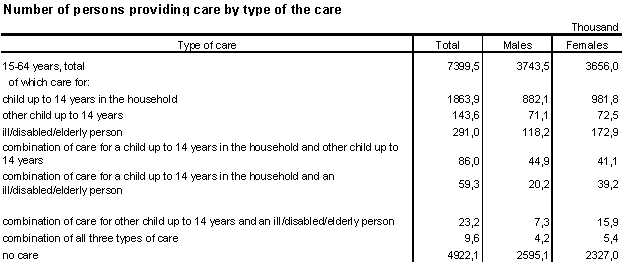
Remark: For this survey purposes care shall mean such care, which is provided regularly (weekly, monthly). Providing of financial support was not monitored. Similarly, care for other children or the elderly, which was volunteering or charity in its nature, was also not considered the care monitored. The care also did not involve cases when this activity was carried out as a job. On the contrary, if a respondent was receiving only financial support for the care for a disabled or elderly person and cared for this person on regular basis, then he/she was considered a carer.
Females dominate males in almost all types of the care monitored. In one of the most frequent cases of care the index of the number of females to that of males in the group caring for own child up to 14 years of age reached 111.3 and in the other case of care for an ill person aged over 15 years and elderly persons there were even 146 females per 100 caring males.
The young persons aged up to 19 years, who are in majority economically dependent, were providing care monitored in absolutely rare cases. In relation to the fast growing number of persons preparing for job solely one tenth of the young aged 20-24 years was providing such care. In the group aged 25-29 years this care was provided by less than one third of respondents, which is connected either to later economic self-subsistence or with ever higher age when family is started. At the same time a fast growth in the number of households of the young, who live and manage on their own, can be observed.
The share of care providers rapidly increases in the group of trigenarians. Some type of care was provided by two thirds of persons in the group aged 30-34 years, in the group aged 35-39 years this number already accounted for three quarters of all respondents. Trigenarians are the largest group providing the care monitored, especially the care for own child. In the group of quadragenarians the total extent of care is decreasing. Besides demographic factors, this was also caused by the fact in the survey the care for persons aged 15 years and more was monitored only in the case the person was either ill or the elderly. The number of care providers is plummeting after fifty years of age have been reached and in the group 60-64 years of age it was merely every seventh respondent, who provided such care.

The share of females providing some type of care has been still outnumbering the share of males up to age of forty years. In the age group of quadragenarians, yet also in the age group of 50-54 years, the share of caring males is, on the contrary, higher than that of females in the total number of females of this age. This is caused mainly by an age difference in between partners. Once they have reach fifty years of age the share of caring females is higher than that of males again.
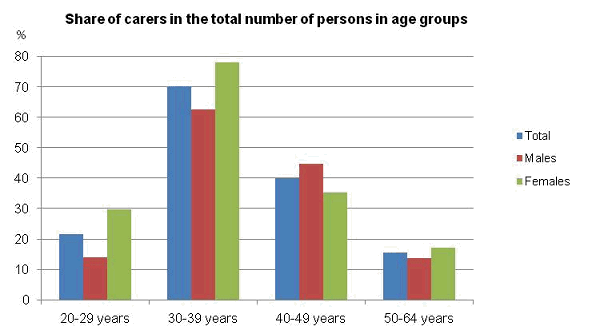
The previous data expressed the share of caring males and females in the total number of males and females of a given age, respectively. Respective types of care, however, differ substantially concerning age structure of persons who provide the care. Care for a child up to 14 years in the household is clearly cumulated into the interval of respondents aged 25-44 years. Respondents of this twenty-year-wide group represent almost 90% of all persons caring for their children right in the household. The long-term population development is reflected in the fact that the highest number of these persons is in the group aged 35-39 years.
The age structure of persons caring for other child up to 14 years of age in the household, that means a child not living in the same household or the respondent takes care of so-called foster child, is completely different. This is often a regular care provided by grandparents. Forms of such care include babysitting and guarding, assistance with homework, reading and playing with the child, etc. The number of men providing the regular care for these children is, on the contrary to the care for his/her own child in the household, equal to that of women. In the wide interval of age up to fifty years men caring for a child outside the household outnumber the corresponding number of women. This is a consequence of the care for their own child from the previous partnership. After the parents’ separation children mostly remain to stay in the joint household with their mothers but their fathers are still taking regular care of them. This practice is shown in the fact that the combined care of children in the household and outside the household is the only monitored type of care, in which men dominate women.
While care for children up to 14 years of age is mostly provided by respondents in the younger and middle productive age, the group of person caring for the ill or disabled older than 15 years of age or for the elderly is clearly dominated by persons of the older productive age. This care is almost in two thirds provided by quinquagenarians and older respondents.
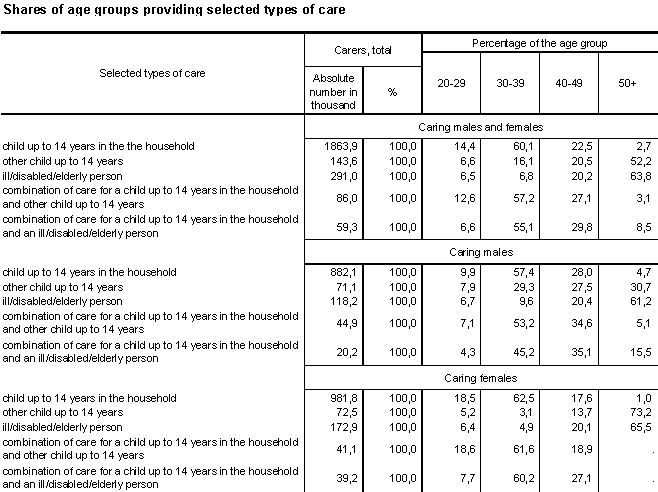
-
II. Harmonizing of family and work life in the group of respondents caring for children up to 14 years of age in the household
Over two million persons aged 15 to 64 years took care of their children or spouses’ children right in the household. This is the group of respondents, which is imminently troubled with harmonising of family and work life. Care for a child in the household is still provided by women at higher extent. Women outnumber the number of men by 116 thousand. This is determined, first of all, by the current practice when after the parents’ separation the child mostly remains to stay in mother’s household, or mother has been taking care of the child herself since the birth. The domination of the number of caring women over men is also clearly indicated in respective groups of respondents by age of the youngest child.
The survey results have confirmed great changes to the educational structure of respondents. While persons with secondary education without A-level examination are the most frequent carers for a child in the household (42.4%) in the group of children aged 6-14 years, in the group of respondents caring for the youngest child at the age 3-5 years or 0-2 years respondents with secondary education with A-level examination prevail. Remarkable is the share of university graduates in the care of a child aged 0-2 years in the household. Almost a quarter (23.9%) of carers of children of this age in the household had completed tertiary education.
Changes to the educational structure are demonstrated both in men and women. The main difference in the educational structure of men and women in our society does not come from the difference of shares of basic education and higher education yet in the share of secondary education. Over a long-term the Czech Republic has been featuring a high share of men with secondary education without A-level examination (skilled workers) and extraordinary high share of women with secondary education with A-level examination. In general, the Czech Republic features the highest shares of these groups in the whole Europe. The number of women with secondary education with A-level examination caring for a child up to 14 years is higher than the number of men of this attainment of formal secondary education by more than a half in absolute numbers (relatively expressed it is 43.3% of all caring women compared to 32.1% men).
The fast growing number of university graduates is especially obvious in women. This is naturally shown in the absolute number and relative representation of women university graduates caring for their children, namely in children up to two years of age. The higher number of women graduates than that of men graduates is affected by differences in the educational structure trends of both sexes, and also by the increasing number of women, who raise children alone, respectively.
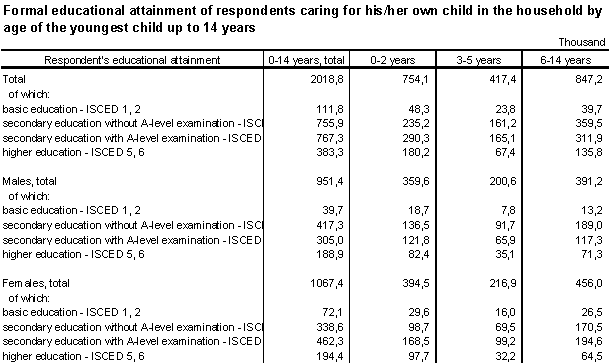
While in men economic activities are affected a little by the child age, the child age shows essential influence on economic activities in women. This is typically right for the care for children younger than three years of age. A great majority of mothers uses the option of the parental leave (or drawing of parental allowance). These women are, according to national legislation, taken in vast majority as persons, whose work legal relations to the employer is regulated by legal standards, yet for purposes of international comparison they are classified as economically inactive. What is remarkable is the fact that a relatively significant number of women (almost 70 thousand) is not able to find a job once the child has reached three years of age or during the child school education and therefore substantially increase the total number of the unemployed (over 35% of all unemployed women). If we take into account also women, who do not seek job in active manner yet they would like to take a suitable job, then numerous mothers have severe troubles with their placement on the labour market.
Data confirm that the issue of the accord of family care and economic activity concerns almost exclusively women. Therefore it is necessary to concentrate namely on availability of suitable childcare, which would enable mothers to return to job faster, or carry out their jobs or professions at full effort. The prevailing portion of women caring for children up to 14 years of age do not use any service of organisations or persons dealing with such childcare at professional level (759 thousand of 1 067 thousand of all child-caring women, i.e. over 71%). The relation in between the use of available childcare and economic activity is principally affected by the age of the youngest child.
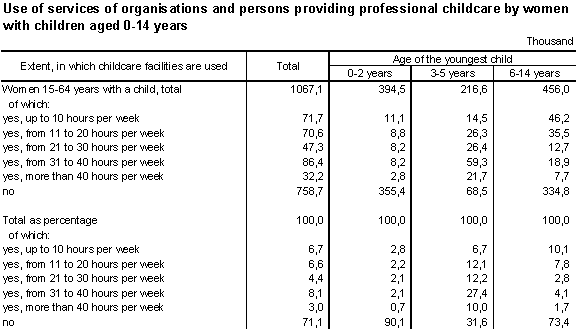
On the contrary to conditions in the 1970s, for instance, services of crèches for children aged 0-2 years are very low in use. The share of women using this option does not reach 10%. It is right mothers with little children up to two years of age who state they cannot use services of organisations providing childcare. Insufficient capacity or unfitting allocation of services, which meet requirements for quality or reasonable financial costs, then affect the possibility for return to work or expansion of work activities.
Substantially different are conditions in the group of mothers caring for the youngest child aged 3-5 years. This means namely wider use of preschool facilities especially nursery schools. Almost 70% women regularly send their children into these facilities. Moreover, the facilities are used in a very intensive manner. If mother have already been using these services, then the use is at such extent for she is able to join a job, even a full-time one. Over one half of mothers send their children to nursery schools for 30 hours per week, at least. The data, however, do not include cases of long-term care to these children provided namely by grandparents. The extent of participation of other institutions and persons in care at this age of children is therefore significant.
The conditions essentially change once the child enters basic school. Services of childcare organisations are used, annually and on average, by merely every fourth woman caring for children aged 6-14 years. A prevailing portion of women use these services at a limited extent of up to 20 hours per week.
In total 68 thousand carers for children up to 14 years of age gave that unavailability or unsuitability of services have adverse effects on the work options. In practice these carers are only women, men almost do not feel this issue at all. According to the survey results it is especially mothers caring for children up to three years who miss the services. First of all, it is lack of crechés that causes every ninth woman caring for a child of this age may not at all, or in a limited extent, join a job. Lack of suitable facilities affects also the group of women caring for children of preschool age.

Unavailability of suitable childcare facilities affects, first of all, work options of women caring for a child in the youngest and preschool age. In working women, who simultaneously take care of a child and work, there are other factors making their harmonising of their work and childcare that have higher weights. This can be demonstrated on the group of women in the position of women employees.
The overall conditions of working mothers are essentially affected by the arrangement of working hours of employees. The fixed beginning and end of working hours still dominates in employees. Almost three quarters of all women employees carry out their job in this working regime. Next nine per cent have the option to shift the beginning and end of working hours while maintaining the daily number of hours. Therefore over 80% of all women employees have the rigid working hours arrangement with fixed number of daily worked hours. The option of flexible working hours is very low.
Yet compared to the whole group of women employees, mothers caring for children show certain differences. If women employees care for children aged up to two years, but there is not many such women, then they have in majority established fixed beginning and end of working hours as well. Almost every fifth women employee has, however, her working regime established individually based upon an agreement with the employer. By contrast to other women the women caring for the smallest children have also higher option of other adjustment or of flexible working hours.
The share of arrangements, which enable also intensive family care, however decreases as the child age increases. In women employees taking care of children of preschool age solely every fifth woman has the option to use flexible working hours. If women care for the youngest child of school age then shares of respective types of working hours arrangement almost do not differ from such structure in the wide group of women not caring for any child aged up to 14 years.
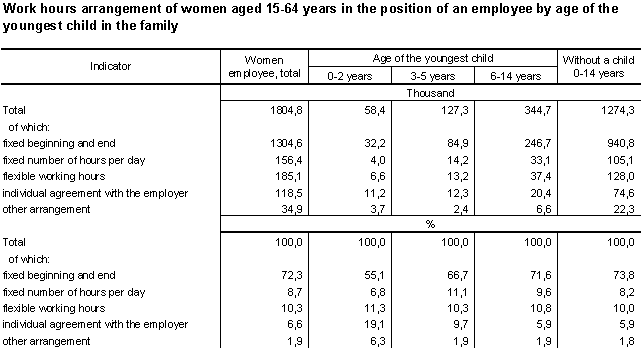
Respondent’s possibility to take at least one day off for family reasons beyond the framework of vacations or days off according to the Labour Code was also sought within the ad hoc module. This possibility is available (in general or at least rarely) to 75% of all employees. The difference in between men and women in the whole survey target group aged 15-64 years is minimum. It is. however, clear that women with little children have the agreement with the employer beyond the framework of the days off as established by law more frequently. It is 80% of all women employees who can use this option in the case of care for a child up to five years of age. In women employees caring for a school-aged child a great increase in answers “yes, rarely” at the expense of the general option can be observed.
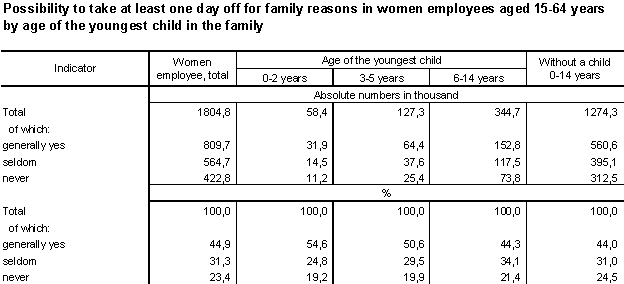
All respondents taking care of a child aged 3-8 years were questioned if they have had an option not to work for 1 month at least for this care (except for the maternity leave). Answers to the question are interesting namely concerning international comparison of all EU countries. (It can be assumed that Eurostat will publish data in the course of 2012.) In the Czech Republic this option is virtually not used by men, on the contrary, almost 90% women have used it. A prevailing portion of them were, quite logically, women on the parental leave, or other women as, for instance, businesswomen or women in the household who cared for little children and were drawing parental allowance at the same time. In the overall view, those who had not used this option were not businesswomen yet women employees. These were mostly women with secondary education with A-level examination as minimum, who speeded up the return to their jobs.
The aforementioned findings are in accord with responses to the question in families with the youngest child aged 1-8 years, if in the past, or at present respondents used the parental leave. Solely 1% of questioned fathers were on the parental leave while in women this percentage was over 85%. If cases, when women were not entitled to use the option following from the legal protection of women employees (parental leave) as, for instance, businesswomen or other women drawing parental allowance, are taken into account, the results indicate that this option was not used by mere 3 per cent of women with little children. These were again dominated by employed women with a higher educational attainment, who for professional reasons, started to work again after the parental leave.
* * * * *
One third of persons aged 15-64 years take a regular care of children or the elderly. The relatively lower number of children is affected, first of all, by the decrease in natality in the second half of the 1990s and in the first decade of this millennium. Total fertility of women attained the lowest values below the limit of 1.2 in the period of 1996-2003. Since 2004 fertility exceeded the limit of 1.2 and in the last three years has shift close to 1.5. According to preliminary demographic results it reached 1.49 last year. An important factor is, also the fact that the time of education is prolonged, the age limit for starting family is increased, and the number of households of singles in the young productive age has been fast growing.
What clearly prevails is the care for children aged up to 14 years right in the household, essentially less frequent is respondents’ care for the elderly. Since 1995 life expectancy has increased, over fifteen years, by 4 years in females and even by 4.7 years in males. In parallel to the population ageing requirements for providing of regular care from relatives and friends, yet also namely for professional social facilities, community care, and specialised health care establishments will be growing as well.
The clear inter-generation relation in between respondents of a younger age and of the mid-productive age of 30-49 years and their children is demonstrated. Simultaneously, respondents, who have already reached fifty years of age, are those who provide care for the elderly.
The age of the youngest child plays the most important role in the harmonising family and work life. Mothers taking care of children up to 3 years of age unambiguously favour the option of the parental leave, or receiving of parental allowance, respectively. Data confirm that this group of respondents missed the option of a wider utilisation of services of organisation providing childcare (crechés) than the females caring for older children. Women with preschool aged children also feel the lack of suitable and available care. Although majority of women in this age use such facilities in a very intensive manner.
Mothers mostly work in the regime with fixed beginning and end of work hours, or fixed number of hours per day. Women employees with little children, however, have the option to use flexible work hours or have an individual agreement with the employer more frequently than other women.
It follows from available data that the Czech Republic belongs to countries with the lowest share of part-time jobs within the whole EU. Transition from a full-time job to a part-time one for women, or even for fathers with children, is, however, subject to a financial reimbursement of the carers is high enough even in the part-time job, because at present the average amount of income is substantially lower than in majority of the “old” EU Member States.
Archive:
- year 2017 | 4th quarter of 2017 | 3rd quarter of 2017 | 2nd quarter of 2017 | 1st quarter of 2017
- year 2016 | 4. quarter of 2016 | 3. quarter of 2016 | 2. quarter of 2016 | 1. quarter of 2016
- year 2015 | 4. quarter of 2015 | 3. quarter of 2015 | 2. quarter of 2015 | 1. quarter of 2015
- year 2014 | 4 quarter 2014 | 3 quarter 2014 | 2 quarter 2014 | 1 quarter 2014
- year 2013 | 4th quarter of 2013 | 3rd quarter of 2013 | 2nd quarter of 2013 | 1st quarter of 2013
- year 2012 | 4th quarter of 2012 | 3rd quarter of 2012 | 2nd quarter of 2012 | 1st quarter of 2012
- year 2011 | 4th quarter of 2011 | 3rd quarter of 2011 | 2nd quarter of 2011 | 1st quarter of 2011
Show all
Hide
Published: 06.05.2011
The data are valid as of the release date of the publication.
Contact: Information Services Unit - Headquarters, tel.: +420 274 056 789, email: infoservis@czso.cz










